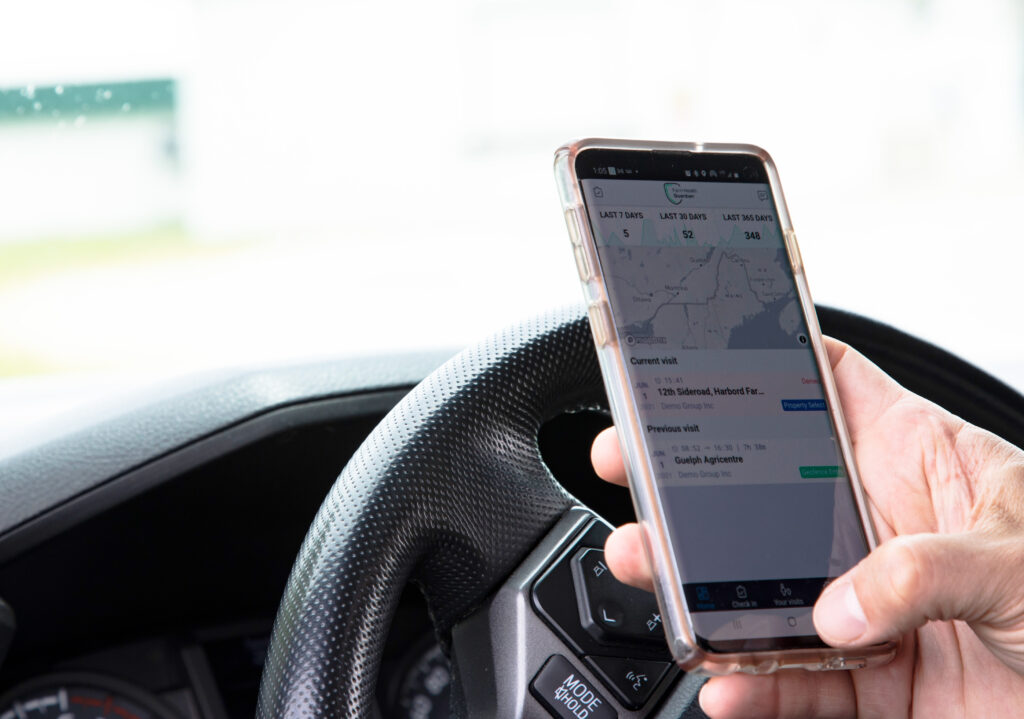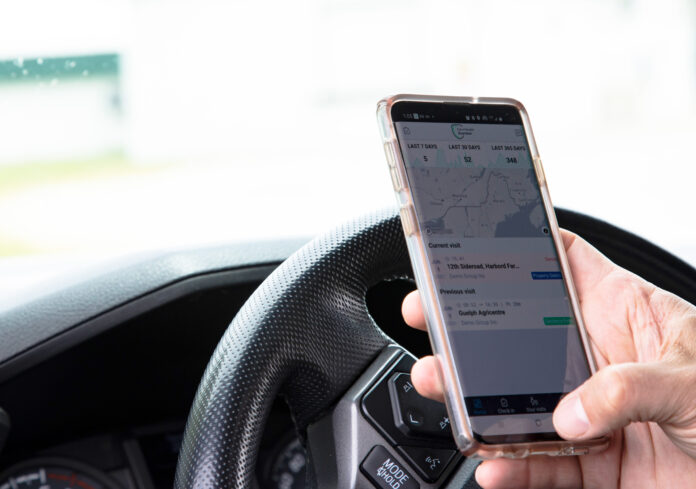By Treena Hein

As the importance of biosecurity continues to be increasingly better understood, biosecurity practices have evolved to become more efficient and effective for producers.
Farm Health Protect – a digital solution offered by Farm Health Guardian – is currently being used on about 600 swine properties in Canada, including about three-quarters of Manitoba pig farms, along with 100 more in the U.S. Farm Health Protect, formerly knows as ‘Be Seen, Be Safe,’ is a Canadian-made subscription-based system that offers a range of biosecurity services.
First and foremost, it confidentially records farm visits through a computer-based application, relying on GPS beacons attached to farm vehicles and property that are used for ‘geofencing.’ The GPS boundaries of the property are entered into the system, which then records every time the boundaries are crossed by a system vehicle or device. In addition to keeping a record and offering instant analysis of farm visits, Farm Health Protect can also immediately establish geographical control zones in case of disease outbreaks, sending alerts and reference maps to producers, and more.
The system automatically records the date and time of entries and exits by farm employees and regular service visitors, like trucks for livestock transport and feed deliveries. Upon arrival, visitors receive a notification via the app asking them to answer customizable biosecurity questions. They will then receive approval to enter or be denied until the issue can be sorted out.
Barn visitors are required to fill out a digital visitor logbook, located in the barn entrance or wherever visitors are required to sign in. This can also be customized in terms of check-in questions to ensure visitors meet the barn biosecurity protocols.
The system can also be used for things like enforcing property downtime requirements and rapid-targeted or system-wide communicating with farm workers and other people in the system. This functionality can be used in the case of an animal health concern when employees and visitors may need to be notified in real time.
“An example of this would be messages about manure spreading in a certain area,” said Rob Hannam, CEO, Farm Health Guardian.
Overall, Hannam explains that Farm Health Guardian helps farmers and agri-food companies better understand what’s happening on their properties and make better management decisions, proactive or otherwise.
“Part of this includes notifications if there’s a breach of biosecurity,” said Hannam. “We’ve developed a feature that will provide alerts to notify people if there’s been a breach such as a truck wash, downtime between barns, health pyramid or the order in which trucks are going from farm to farm.”
On-farm implementation finding success

Topigs Norsvin Canada has been using Farm Health Protect on their breeding farms in Saskatchewan and Manitoba for close to two years at this point. The company’s veterinarian, Brad Chappell, says it was implemented as part of Topigs Norsvin’s ongoing prevention of disease on its premises and its preparedness for the potential arrival of foreign animal diseases.
“We’d always been very detailed about biosecurity, but it’s impossible to track all farm traffic and do a rapid search of visits without the electronic records that a system like this provides,” said Chappell. “It’s a big step up from that piece of paper in the barn. Minimum once a week, I look at who has come on the properties and into the barns to see if there was anything unusual – was anyone is denied entry, to see what was delivered. It’s helped us analyze whether there are things coming in that don’t need to. Every visit is a biosecurity threat.”
The installation was smooth, and implementation among the staff required higher-level oversight to ensure everyone is trained and using the system without issues. Going digital with this aspect of operations has been a change in workplace culture for Topigs, and any culture change takes a little while to achieve.
“The other nice feature is you’re able to ask questions of people before you decide to admit them,” said Chappell. “We have service people who need to go into the barns, and they may be new to the job, and the system ensures they read the rules – no pork meat for lunch, for example – but we also ask questions to make sure they are abiding by the rules.”
The Maschoffs, based in Illinois, are one of the largest family-owned hog production networks in North America. They recently trialled Farm Health Protect because the geofencing and tracking system allowed more transparency with feed and livestock trailer movements. The current scope of the pilot project involves more than 100 properties with geofences, 18 users and 29 trailers with GPS installed.
“Since the start of this year, the system has logged more than 12,000 visits or geofence crosses,” said Kayla Henness, one of the Maschoffs’ veterinarians. “The platform is simple to use, and the ‘Outbreak Report’ feature has been helpful during a health investigation. We are working closely with Farm Health Guardian and moving towards utilizing the platform for truck wash compliance audits, biosecurity breach alerts and people entering sow farms. Our learnings throughout this pilot have ranged from which GPS devices work best, misses on truck movements, as well as transparency to people movements.”
Farm Health Guardian’s reach keeps growing
Chappell has suggested that it would be nice to have a set of questions for property entry in addition to the ones for barn entry.
“I recently presented at a conference in the U.S. about how we use the system, and a person suggested after that it would be useful to be able to take a picture of what service people are bringing into the barn, to have a record of that, but also perhaps it would encourage them to only bring in the equipment that’s really required for the repair or maintenance,” said Chappell. “As people use it, they get ideas for added capabilities and some of those are already going into further product development.”
Farm Health Guardian also recently announced a merger with U.S.-based NoveTechnologies to launch Protocol, a biosecurity management system that utilizes facial recognition technology for controlled barn access. The two companies have joined forces under the Farm Health Guardian banner and operate out of Ontario and Nebraska.
Maple Leaf Foods has also embraced Farm Health Guardian as a traceability and biosecurity digital technology partner.
“Working together, Maple Leaf Agri-Farms has provided Farm Health Guardian with recommendations to adapt and customize the digital biosecurity system for pork production operations across North America,” said Hannam.
With producers constantly looking to get an edge on biosecurity and make it simpler to manage, Farm Health Guardian is one company leading the way to serve farmers while helping to protect the industry at large.






